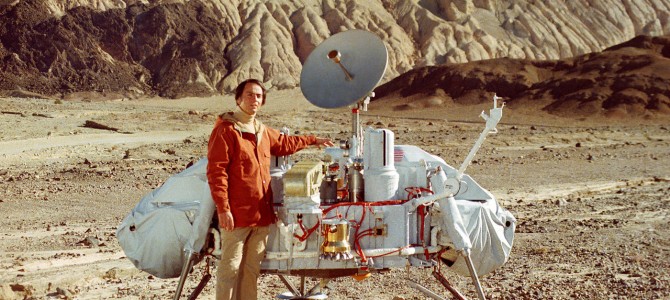
I am a Carl Sagan fan from way back. His 1980 TV miniseries “Cosmos” hit me at just the right age and inflamed a lifelong love of science. But we’ve had nearly 40 years to assess the long-term effects and see how Sagan unwittingly contributed to a trend that muddled public understanding of science. This weekend’s so-called “March for Science” is a perfect example of what went wrong.
All you really need to know about the “March for Science” is that it is scheduled for Earth Day. The organizers may say the march is nonpartisan and has a variety of goals, but it’s mostly just about global warming. It’s not just about whether global warming is actually happening, or whether it is caused by human activity, but about a specific political program for dealing with global warming.
To be sure, there are other goals involved in the march and some contention, even among the organizers, about the extent to which the march should embrace causes like “diversity.” So the goals run the gamut from the left to the far-left. And that’s the problem. The “March for Science” is an attempt to equate the Left’s political goals with Science Itself, claiming the intellectual and moral authority of science for the Left’s agenda.
You can see why they would want to do that. The Left’s latest worker’s paradise—this time in Venezuela—is finishing up the usual devolution into mass poverty, starvation, dictatorship, chaos, and gang warfare. Given this ongoing track record of destruction, the Left has to seize on the illusion of moral authority however it can.
This is an old campaign—the Communists used to claim that they represented “scientific socialism”—but its modern form was largely shaped by Sagan, by way of “Cosmos.” He is remembered as a great popularizer of science, explaining the achievements of physics, mathematics, and astronomy in glowing, inspirational terms. But he faced the basic problem of all such popularizers.
Science has its own unique language and methods: the language of mathematics and a method of systematic observation and experimentation. The reason science tends to be opaque to the public is because it ultimately requires that they understand its language and learn to use its methods. But how do you communicate the history and meaning of science to those who don’t yet speak its language? You turn science into something they can understand. You make it into a narrative, a story.
Sagan mostly turned it into a story about brave and honest scientific pioneers fighting against the forces of superstition and obscurantism. He made it into a narrative of good guys versus bad guys, of the forces of light and progress against closed-minded reactionaries. This was sometimes oversimplified, but it wasn’t entirely wrong; the religious authorities who persecuted Galileo definitely weren’t the good guys. But Sagan fell into the temptation to make this narrative about science fit just a little too closely with the agenda of conventional late-twentieth-century liberalism, so he used “Cosmos” as a platform for the Cold War-era moral equivalence of the “anti-nuclear” movement and homilies about environmentalism.
“Cosmos” is an interesting intellectual time capsule, because it was broadcast just at the point when predictions of global environmental catastrophe were tipping between global cooling and global warming. So he presented the two as equally likely scenarios that required further study (and, of course, massive government funding).
But he dropped his guard at this point, forgot his own admonitions about following the evidence wherever it leads, and indulged the conceit that science would just happen to line up neatly with his own political preferences. What he didn’t do was entertain the possibility that human beings aren’t destroying the planet or cruising toward planetary catastrophe. He did not even consider this null hypothesis as a possibility.
It was a glaring hole in scientific objectivity, and it set the path for the popularizers of science who would follow in his footsteps. He had fixed the narrative in place, and they followed it.
Like I said, I’m a big fan of Carl Sagan. There was a lot of merit in his history of science, his style was thoughtful, and he was adamant about the principle of tolerance for opposing ideas. People like Bill Nye who muse about imprisoning “climate deniers” are unworthy of claiming any part of his legacy. Yet that has been the trend.
Sagan clearly hoped that his stirring narrative about science would inspire young people to go beyond and beneath the narrative and learn the actual method of science. Instead, his successors saw the success of his approach—in terms of attention and celebrity and moral authority—and chose to use the narrative as a substitute for science.
If you don’t really need science so much as the narrative, then what you get is our own era’s official replacement for Sagan: Neil deGrasse Tyson. As the decades pass, Sagan’s imitators become less thoughtful and more propagandistic, less interested in conveying the actual scientific method and more concerned with just telling the public what to think. It’s also about making those who accept the approved “pro-science” political agenda feel they are superior to all of those ignorant, knuckle-dragging bigots who disagree with them. It equates science, not just with the politics of the Left, but with the Left’s attitude of smug condescension. That’s how you get Tyson’s fake-but-accurate narratives or the meme-swapping superficiality of the IFL Science crowd.
That’s also how we get things like the March for Science, in which it is naturally assumed that defending science dovetails perfectly with the Left’s “resistance” against the current administration and every part of its agenda. It reduces science to a narrow political pose and blinds people to its big questions and radically different method of inquiry.
Popularizers like Sagan ended up achieving the opposite of what they set out to do. But every failed experiment is just an opportunity to learn something, and what we learned here is that science cannot be promoted by turning it into a political narrative—not without losing its distinctive virtues.









